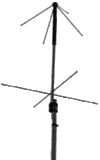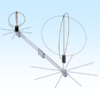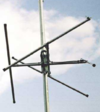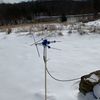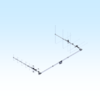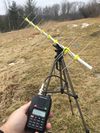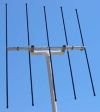Difference between revisions of "Antennas"
m (Updated link for VK4ADC Turnstile antennas) (Tag: Visual edit) |
(Tag: Visual edit) |
||
| (2 intermediate revisions by 2 users not shown) | |||
| Line 26: | Line 26: | ||
[https://network.satnogs.org/stations/129/ 129 - Chabot Space And Science Center] | [https://network.satnogs.org/stations/129/ 129 - Chabot Space And Science Center] | ||
| − | [https://network.satnogs.org/stations/ | + | [https://network.satnogs.org/stations/984/ 984 - KJ6DZB] (with modified reflector) |
*[https://www.wimo.com/scanner-antennas_e.html#004 Product link] | *[https://www.wimo.com/scanner-antennas_e.html#004 Product link] | ||
| Line 134: | Line 134: | ||
*[http://jcoppens.com/ant/qfh/calc.en.php QFH Calculator by ON6JC/LW3HAZ] | *[http://jcoppens.com/ant/qfh/calc.en.php QFH Calculator by ON6JC/LW3HAZ] | ||
*[https://community.libre.space/t/an-easy-3d-printed-quadrifilar-helix-antenna/1487 3D Printed UHF QFH Antenna by surligas] | *[https://community.libre.space/t/an-easy-3d-printed-quadrifilar-helix-antenna/1487 3D Printed UHF QFH Antenna by surligas] | ||
| + | *[https://www.thingiverse.com/thing:4737259 3D Printed VHF QFH Antenna based on G4ILO's dimensions] | ||
|- | |- | ||
| | | | ||
| Line 266: | Line 267: | ||
<p></p> | <p></p> | ||
| − | <p>A radome design is available from SatNOGS. This will protect the ground station from the elements in all but | + | <p>A radome design is available from SatNOGS. This will protect the ground station from the elements in all but extraordinary conditions. The design can be found [https://gitlab.com/librespacefoundation/satnogs/satnogs-radome/blob/master/satnogs-radome-v1-bom.ods here] and construction guide [https://ohai.libre.space/project/satnogs-radome-v1/satnogs/ here]. </p> |
[[Category:Antenna]] | [[Category:Antenna]] | ||
[[Category:Hardware]] | [[Category:Hardware]] | ||
Latest revision as of 06:25, 26 August 2021
The type of antenna largely depends on the type of ground station. A no rotator ground station will benefit from a different type of antenna (omnidirectional) than a rotator based ground station (directional). The two different approaches are explored below. In addition to the choice of antenna the choice of location for the ground station will have an effect on the quality of observations.
Non-Rotator Ground Station (Omnidirectional)
This type of ground station will require an antenna that will give a broad coverage from its fixed position. It is therefore not just the antenna that needs to be considered but also the proximity of buildings, geography or metallic structures that might be in the path of a line of sight between the ground station and satellite.
Typical ground stations have had success with simple wire antennas that can be commercially bought or made at home. Colinear or ‘white stick’ antennas are vertically polarised omnidirectional antennas. These have anecdotally been used for successful satellite work but should be avoided. The following are considered suitable choices:
It is highly recommended that you use a mast-mounted Low-Noise Amplifier (LNA) with these antennas.
Commercial Antennas |
Homebrew Antennas | |
|---|---|---|
WiMo TA-1VHF Turnstile Estimated cost: 90€ Some SatNOGS stations using this antenna: 141 - balcony-only-east-passes 129 - Chabot Space And Science Center 984 - KJ6DZB (with modified reflector) |
TurnstileEstimated cost: TBD Some SatNOGS stations using this antenna: | |
M2 EggbeaterVHF / UHF Eggbeater Antennas Estimated cost: $304 (VHF), $280 (UHF), $573 (combo) Some SatNOGS stations using this antenna: |
LindenbladEstimated cost: TBD Some SatNOGS stations using this antenna: | |
Winkler TurnstileVHF/UHF Turnstile Antennas Estimated cost: 40€ (VHF), 30€ (UHF) Some SatNOGS stations using this antenna: |
UHF Parasitic LindenbladEstimated cost: $15 (with access to a 3D printer) Some SatNOGS stations using this antenna: | |
Quadrifilar Helix Antenna (QFH)Estimated cost: TBD Some SatNOGS stations using this antenna: | ||
"Turnstiled" MoxonEstimated cost: TBD Some SatNOGS stations using this antenna: |
Rotator Ground Station
A rotator based ground station is able to make use of directional antennas. These will have a directional gain, meaning that you will need to point them in the direction of the satellite but the signal you receive will be stronger and for longer. They will allow much lower to the horizon passes to be received and more successful observations. These are not complex antennas but the choice will depend on the type of satellite and there are variations on the main types: yagi, helical and quad.
Commercial Antennas |
Homebrew Antennas | |
|---|---|---|
M2 Circularly Polarized YagisVHF/UHF Cross-element Yagi Estimated cost: $296 (UHF), $296 (VHF), $638 (Combo kit) Some SatNOGS stations using this antenna: 834 - Valpo WIRED Lab 1 - (2MCP14 and 436CP30 ~3.3m booms) |
Yagi Antennas, Cross-element yagi antennasVHF/UHF directional antenna Estimated cost: TBD A common type of antenna that is either horizontally or vertically polarised. Simple to construct and suitable for a large number of satellites. Some SatNOGS stations using this antenna: TBD
| |
WiMo X QuadVHF/UHF Cross-element Quad Estimated cost: 149€ (VHF), 149€ (UHF) Some SatNOGS stations using this antenna: |
Helical AntennasUHF circularly polarized directional antenna Estimated cost: TBD A less common type that are circularly polarized. The antenna looks a bit like a corkscrew and can be either LHCP (Left hand circular polarisation) or RHCP (right hand circular polarisation). Some SatNOGS stations using this antenna: | |
Arrow Dual-band portable yagiVHF/UHF portable yagi Estimated cost: $83-$149 Some SatNOGS stations using this antenna: TBD |
||
Elk Log PeriodicVHF/UHF portable yagi Estimated cost: $130-$163 Some SatNOGS stations using this antenna: TBD |
A radome design is available from SatNOGS. This will protect the ground station from the elements in all but extraordinary conditions. The design can be found here and construction guide here.
